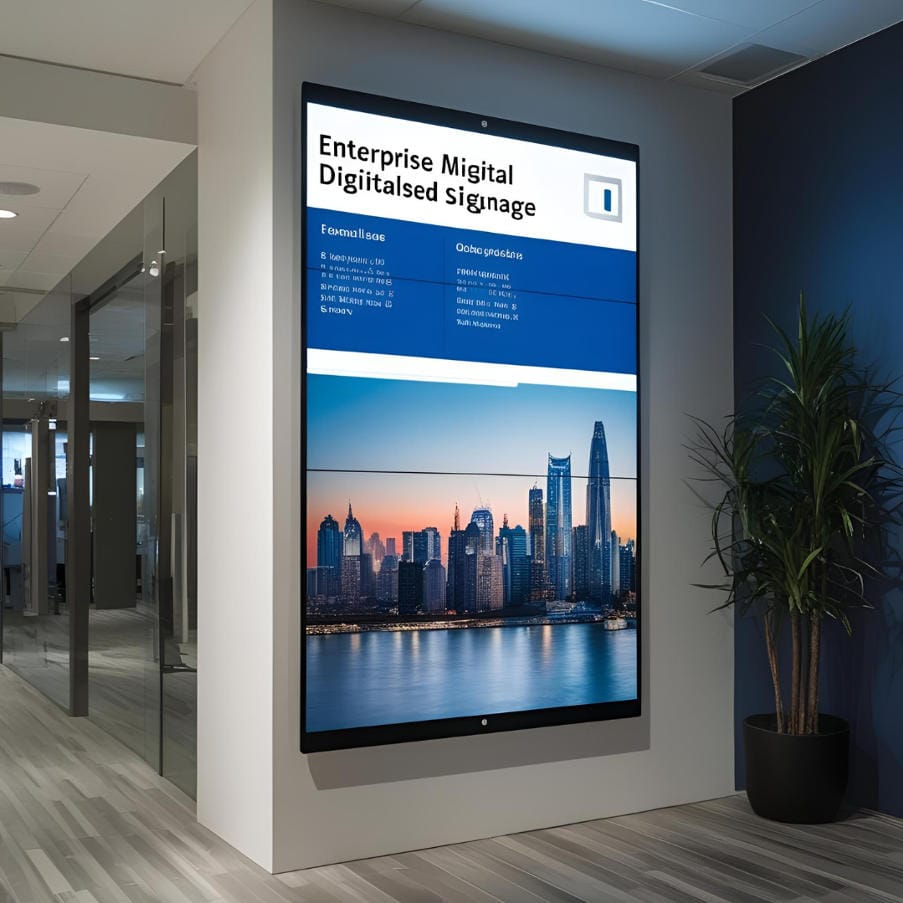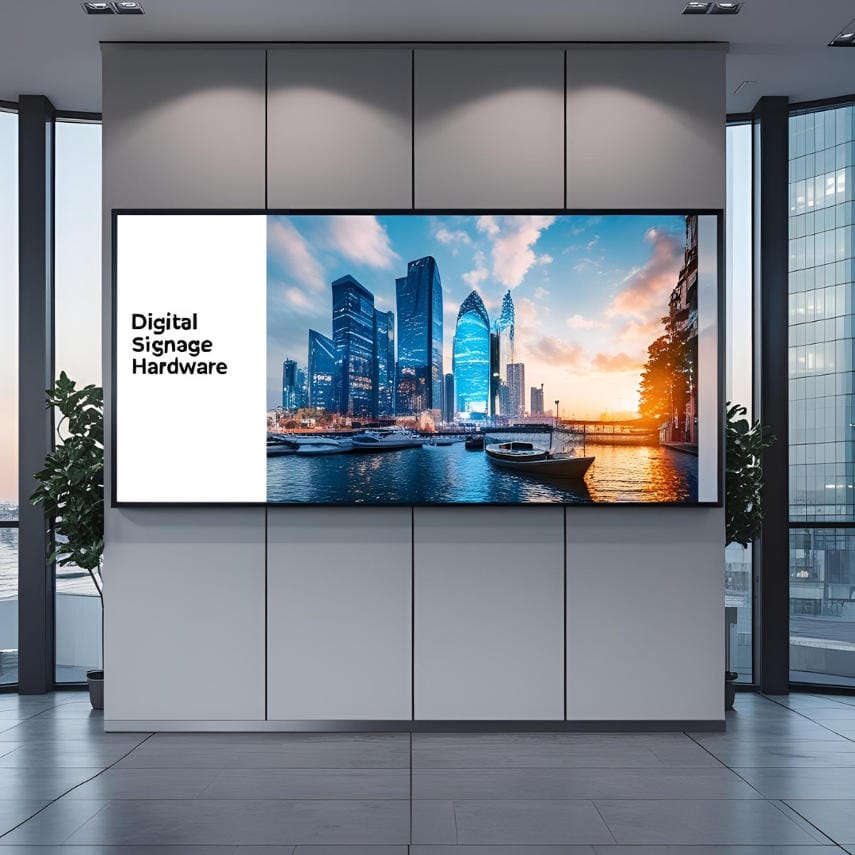With digital displays, every screen can show your brand’s data and help you engage with your customers. Even the most impressive motion graphics and dashboards fail to impress if the digital signage hardware running them isn’t reliable and suited to where they’ll be used. We’ve made a step-by-step guide that gives you essential points, input from manufacturers and advice on installing furniture to ensure you feel confident when you buy.

Essential Components of Digital Signage Hardware
Media Players – The Processing Power
Your media player downloads content from the cloud (or local server) and displays it in 4 K, HTML5 or touchscreen form. Look at how fast the CPU, GPU, and on-board storage are and also check what OS it uses so it supports every task from simple presentations to advanced AI.
Displays & Screens – The Tool for Visual Art
You can use LED or LCD panels in stores without fear of burn-in, even if they are on all day or night. For storefronts, you’ll need displays with high brightness; for video walls, pick those that join seamlessly; and for self-service kiosks, choose tough touch panels.
Mounting & Kiosk Hardware – Keeping the Device in Place
The mounting you choose for your wall, ceiling or pedestal must be able to handle the screen’s weight, fit its VESA pattern, allow the right viewing angles and follow ADA rules. Using certified brackets stops vibration, but mobile carts give you flexibility for events that open and close.
Always Online – Staying Connected
Media streams are maintained by using Cat-6 cabling, fiber extenders, PoE injectors and dual-band Wi-Fi. Enterprise routers allow you to separate signage traffic from POS or guest networks, making both networks less crowded and safer.
Shielding and Climate Control in Environmental Enclosures
Sealed IP-rated housings are used for drive-thru menu boards and factory floors because they protect electronics from rain, dust, vandalism and changes in temperature. There are options for anti-glare glass, built-in fans that heat or cool and heater kits for sites that get very cold.

Key Factors When Choosing Digital Signage Hardware
Business Goals & Content Strategy
Decide if you want your customers to use promo loops, view real-time dashboards or order on their own. For 4 K video with lots of motion, GPUs and bandwidth need to be stronger than those used for simple menu boards.
Location & Stress to the Environment
Lobbies inside buildings don’t require as much brightness or as heavy a mounting as outdoor pylons. Assess the amount of light, humidity, temperature range and the possibility of an impact as part of your decision on screens and enclosures.
Screen Size, Resolution & Viewing Distance
A 10-inch display near products looks best in 1080 p, but a 75-inch lobby screen or 2 × 2 video wall needs 4 K resolution and thin bezels to look great.
Durability, Power & Total Cost of Ownership
Choose panels that are rated for 50 000–100 000 hours, have energy-saving backlights and have anti-burn-in circuitry. You can save on power bills by using media players that consume less energy if you have numerous units.
Compatibility With Digital Signage Software
Check that your CMS can run the media-player OS, process the codecs you will use, understand touchscreen gestures and integrate with any data systems you have (POS, queue systems, social feeds). When this does not match up, it stops the best hardware from working properly.
Top Digital Signage Hardware Manufacturers
Samsung, LG and NEC control the high-brightness commercial display market; BrightSign and IAdea are at the top of fan-less media players, while ViewSonic and Philips offer reasonable prices for SMB displays. When scaling your digital signage, working with proven manufacturers ensures the availability of parts, updates to firmware and support in many countries.
Digital Signage Hardware Installation
Installation of digital signage hardware begins with a check of the site’s power circuits, wall strength, HVAC and network drops. After that, certified technicians mount the screens to code, insert cables in raceways, label every port, set static IPs and run a few playback tests. Training users and handing over a list of final tasks helps your team feel ready for daily reboots or firmware updates.

Aligning Digital Signage Hardware and Software
OS & Codec Support
For Android users, CMS clients must be in APK format, but Windows players require EXE ones. If you want cinematic visuals, be sure H.265 or VP9 decoding is supported for 4 K footage.
Remote Device Management
Select solutions that notify you through a dashboard, allow you to review images and can update firmware for all your locations at the same time.
Integrating Data & API
When showing live menus, flight gates or KPIs, make sure that the player chipset and CMS can use real-time JSON / XML feeds and secure web sockets.
Offline Playback Safeguards
SSD caching makes sure your loops continue to play, even when the network is down and your screen is blank.
Bundled Ecosystems vs. Open Hardware
Closed TV platforms like Samsung Tizen and LG webOS are easy to acquire, yet they don’t permit custom applications; open systems like Android TV encourage more third-party app creation.
Budget, Maintenance & Future-Proofing
You could get a single 43-inch set up inside your home for less than $ 1,500. The cost for multiple sites, outdoor displays, tracking sensors and twin servers can be more than $50,000. Remember that replacement lamps and fan filters are included, plus you get a three-year advance-exchange warranty. To prevent having to upgrade in the future, get a machine with Spec HDMI 2.1 ports and Wi-Fi 6 and 4 K-ready GPUs.
Power Up Your Screens Today
To make great content stand out, you need great digital signage hardware. Set your goals, review the features of each manufacturer and make sure the equipment you buy will work with your software and expand as your business grows. Investing smartly today means your messages will be better, clearer and more dependable tomorrow, always making your brand easy to notice when customers see your ad.
FAQs
What exactly is digital signage hardware?
It includes screens, media players, mounting equipment, enclosures and devices that provide networking support for visuals.
Can I run signage on a consumer TV?
It won’t take long. Consumer sets are not made for 16/7 or 24/7 duty cycles and do not come with firmware for remote management.
Which digital signage hardware manufacturers are most reliable?
Samsung and LG for screen displays, BrightSign and IAdea for media players and Peerless-AV for mounting.
Do I need pro installation?
Licensed installers promise to make your structure safe, arrange cables neatly and fine-tune your displays.
How do I match hardware and software?
Make sure the OS is supported, check if the codecs are compatible and check your site in the CMS before purchasing in bulk.
What’s the lifespan of commercial panels?
According to manufacturers, LED-lit LCDs usually last up to ten years, which is equivalent to 50,000 to 100,000 hours.
Is digital signage hardware expensive to maintain?
Updating your firmware regularly won’t break the bank. Set aside money each year for cleaning your AC and for occasional replacements of the backlight or fan.
Can hardware run offline?
So that screens don’t freeze, quality players keep the content on your phone even if the internet is lost.
Does power consumption matter?
Absolutely. Energy-saving players and LED screens help you save money when you are running many screens at once.
What’s the first step to deploy?
Decide on your goals, review the site and set a budget, and only after that have at least two major vendors offer a demo.





